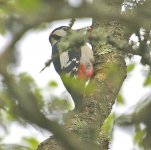Meanwhile the hundreds of little old ladies from here to Shankill who know there are woodpeckers about (on account of their prediliction for peanuts and fat-balls) will be devastated.
Clarification - it´s the woodpeckers have the prediliction for peanuts and fat-balls, not the little old ladies. AFAIK.






